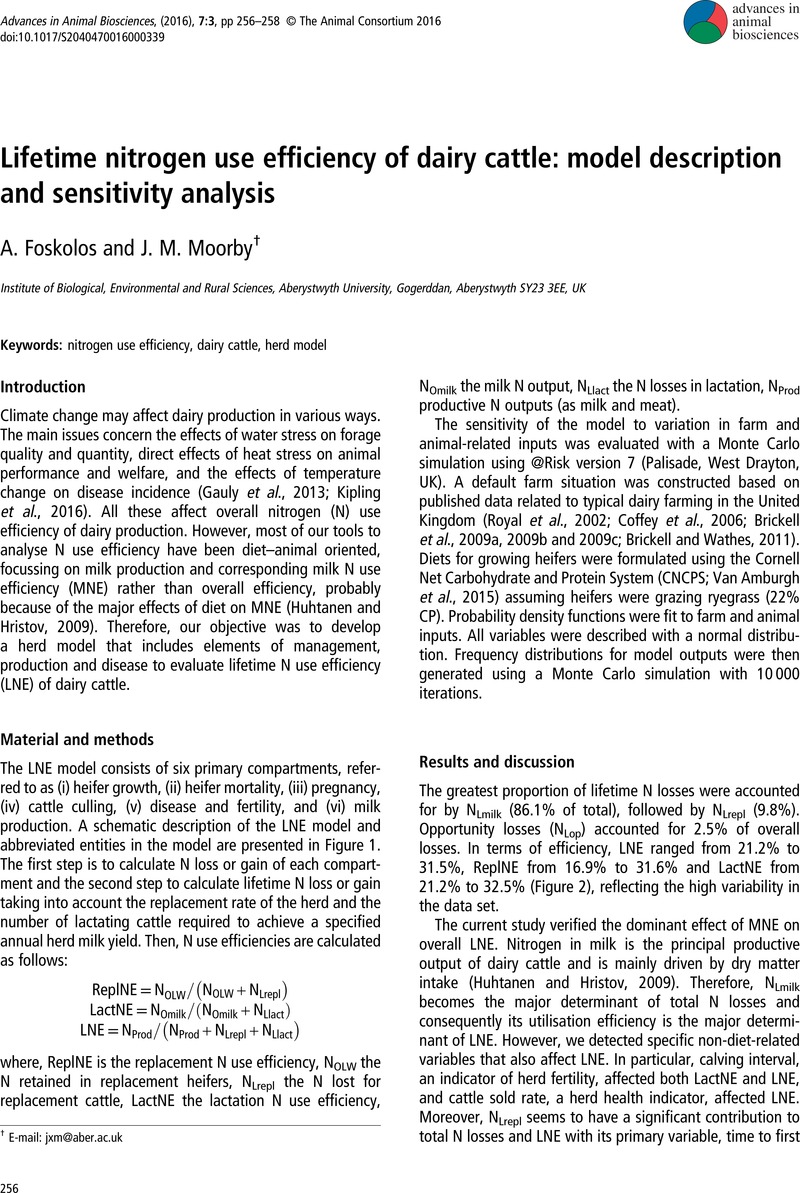No CrossRef data available.
Article contents
Lifetime nitrogen use efficiency of dairy cattle: model description and sensitivity analysis
Published online by Cambridge University Press: 28 October 2016
Abstract
An abstract is not available for this content so a preview has been provided. Please use the Get access link above for information on how to access this content.

- Type
- Full Paper
- Information
- Advances in Animal Biosciences , Volume 7 , Special Issue 3: Proceedings of LiveM 2016: Modelling Grassland-Livestock Systems Under Climate Change , November 2016 , pp. 256 - 258
- Copyright
- © The Animal Consortium 2016
References
Brickell, JS, Bourne, N, McGowan, MM and Wathes, DC
2009a. Effect of growth and development during the rearing period on the subsequent fertility of nulliparous Holstein-Friesian heifers. Theriogenology
72, 408–416.CrossRefGoogle ScholarPubMed
Brickell, JS, McGowan, MM, Pfeiffer, DU and Wathes, DC
2009b. Mortality in Holstein-Friesian calves and replacement heifers, in relation to body weight and IGF-I concentration, on 19 farms in England. Animal
3, 1175–1182.CrossRefGoogle Scholar
Brickell, JS, McGowan, MM and Wathes, DC
2009c. Effect of management factors and blood metabolites during the rearing period on growth in dairy heifers on UK farms. Domestic Animal Endocrinology
36, 67–81.Google ScholarPubMed
Brickell, JS and Wathes, DC
2011. A descriptive study of the survival of Holstein-Friesian heifers through to third calving on English dairy farms. Journal of Dairy Science
94, 1831–1838.CrossRefGoogle ScholarPubMed
Coffey, MP, Hickey, J and Brotherstone, S
2006. Genetic aspects of growth of Holstein-Friesian dairy cows from birth to maturity. Journal of Dairy Science
89, 322–329.CrossRefGoogle ScholarPubMed
Gauly, M, Bollwein, H, Breves, G, Brügemann, K, Dänicke, S, Daş, G, Demeler, J, Hansen, H, Isselstein, J, König, S, Lohölter, M, Martinsohn, M, Meyer, U, Potthoff, M, Sanker, C, Schröder, B, Wrage, N, Meibaum, B, von Samson-Himmelstjerna, G, Stinshoff, H and Wrenzycki, C
2013. Future consequences and challenges for dairy cow production systems arising from climate change in Central Europe – a review. Animal
7, 843–859.Google ScholarPubMed
Huhtanen, P and Hristov, AN
2009. A meta-analysis of the effects of dietary protein concentration and degradability on milk protein yield and milk N efficiency in dairy cows. Journal of Dairy Science
92, 3222–3232.CrossRefGoogle Scholar
Kipling, RP, Bannink, A, Bellocchi, G, Dalgaard, T, Fox, NJ, Hutchings, NJ, Kjeldsen, C, Lacetera, N, Sinabell, F, Topp, CFE, van Oijen, M, Virkajärvi, P and Scollan, ND
2016. Modeling European ruminant production systems: facing the challenges of climate change. Agricultural Systems
147, 24–37.CrossRefGoogle Scholar
Royal, MD, Pryce, JE, Woolliams, JA and Flint, APF
2002. The genetic relationship between commencement of luteal activity and calving interval, body condition score, production, and linear type traits in Holstein-Friesian dairy cattle. Journal of Dairy Science
85, 3071–3080.CrossRefGoogle ScholarPubMed
Van Amburgh, ME, Collao-Saenz, EA, Higgs, RJ, Ross, DA, Recktenwald, EB, Raffrenato, E, Chase, LE, Overton, TR, Mills, JK and Foskolos, A
2015. The Cornell Net Carbohydrate and Protein System: updates to the model and evaluation of version 6.5. Journal of Dairy Science
98, 6361–6380.CrossRefGoogle Scholar


